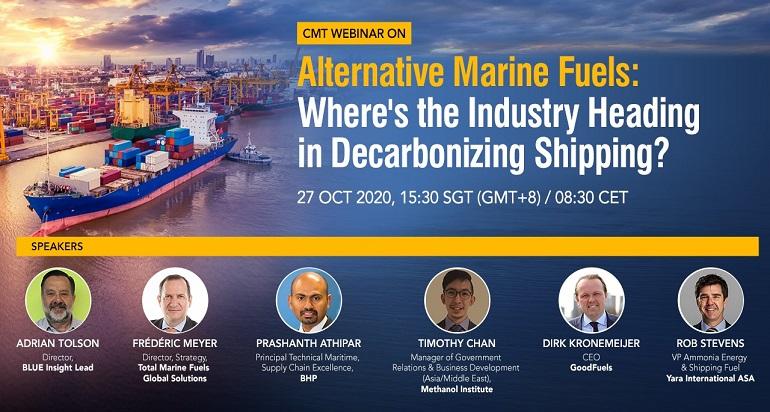CMT Webinar On Alternative Marine Fuels: Supply Chain, Scaleability And Price – Why LNG Is Leading The Way As A Fuel Of Choice
Blog Article - November 06, 2020

I recently spoke at the CMT Webinar on Alternative Marine Fuels – ‘Where is the Industry Heading in Decarbonzing Shipping?’ – joining a panel of leading experts to discuss the latest developments in the alternative marine fuels market.
During the discussion, I highlighted how factors such as fuel maturity, supply chain infrastructure, scalability and price are the key forces driving Liquefied Natural Gas (LNG) as the marine industry’s viable fuel alternative not just today, but for some time to come.
With the global push for decarbonization gathering pace across the marine industry, alternative fuel manufacturers are currently at different stages on their developmental and commercial journeys.
As an industry, we are embracing the opportunity to move to zero-carbon fuels and exploring how we can achieve this – driving emissions down whilst ensuring we provide practical fuel solutions for the global shipping industry.
A number of key factors will ultimately determine what that means in the short, medium and long term:
- Maturity of the technology to adopt new low-carbon fuels
- Supply availability in the ports and main hubs
- Development of bunkering infrastructure
- Scalability of the production
- Affordability of the low carbon fuels
- Global and harmonized incentives towards low carbon fuels and CO2 price schemes
The penetration of LNG in the bunkering market has been driven by the need to further reduce greenhouse gases (GHG) emission and to comply with IMO 2020 regulations to reduce sulphur emissions. In addition, the quick adoption of LNG is backed by significant investment in its infrastructure, scalability and affordability.
In the longer term, the benefits and challenges for future fuel alternatives such as Methanol, Ammonia, Hydrogen and biofuel blends sit at different stages of development.
The question around each of these is not necessarily whether they would help shipping operators reach GHG and CO2 emissions reduction targets but ultimately, whether there will be adequate scalability and availability to make them commercially viable.
LNG Supply and Infrastructure Development Deliver Market Confidence
LNG is often discussed as the ‘transition fuel’ between LSFO/VLSFO and future alternative fuel sources. However, we feel it is much more than that.
LNG is a vital link in the alternative fuel chain. Operators need to have the confidence to be able to invest in vessels without the worry of technology obsolescence and the significant investment in LNG infrastructure globally is giving them just that.
We are looking at an alternative fuel solution that will cover at least 2 generations of operational vessels, whilst development into the practical and commercial applications of wider low-carbon fuel alternatives continues.
There are currently approximately 200 LNG-fuelled vessels operating. Looking at current order levels across the board, the share of LNG-fueled vessels in the order book has increased sizably and reached almost all market segments:
- 22% of the gross tonnage of vessels are LNG propelled (33% container vessels, 27% car carriers, 26% cruise liners, 20% tankers).
- The number of LNG bunker vessels will also more than double in the next 2 years to 33 units.
- 2019 saw a record year of final investment decisions (FID) on LNG supply projects highlighting the confidence and commitment to LNG.
- And there is a global LNG bunker vessel capacity of 7.6 Mt pa – more than enough capacity to cover market growth in the coming years.
At Total Marine Fuels Global Solutions, we are playing a proactive role in driving the development of the global LNG market. As part of an energy major that is the second largest player in LNG, we are actively participating in building industry standards, supporting clients through technical support and working with ports globally to help them develop bunkering strategies.
We are also investing in the development of critical LNG infrastructure globally. A demonstration of this is reflected in our investment in the world’s largest LNG bunker vessel - Gas Agility – which we recently took delivery of, with a second vessel anticipated for delivery in 2021 through our collaboration with Mitsui O.S.K. Lines, Ltd. (MOL).
Changing LNG market dynamics
We have also seen a fundamental change in the LNG market dynamics with the increasing share of spot trading moving us towards a greater liquidity.
And we have seen LNG consistently trading below marine fuel oil prices.
There is discussion about the need to incentivize adoption of alternative fuels through carbon levies by increasing the price of high GHG-emitting fuels. But the fact remains that, LNG aside, future low carbon fuels will not be cheap and may end-up significantly more costly than conventional fuels.
Conclusion
LNG provides a commercially competitive fuel solution towards decarbonizing the shipping industry. Importantly, it provides the added confidence of knowing there is scalability, availability and investment infrastructure to meet all future demands.
With the development of bio and synthetic LNG, we can foresee further cuts in GHG emissions to be possible.
Until low- and zero-carbon fuels are mature and scalable, LNG is the best fuel option to balance the current shipping fuel mix and a key fuel in contributing to a carbon-free shipping future.
To this end, Total is resolved in advancing the development and widespread use of LNG in shipping’s energy mix, as we continue to research and develop low-carbon fuels.

Latest Articles On Our Blog
- Shipping is undergoing a revolution and I can help
- Beyond LNG: How LNG bunkering can speed up the adoption of other gaseous marine fuels
- The Roads to Carbon Neutral: Sharing our commitment to maritime decarbonization with CNBC
- Louise Tricoire’s Outlook of Alternative Marine fuels at the LNG Bunkering & Future Fuel Global Summit 2023
- Biofuels for Shipping: Highlights from Argus Green Marine Fuels Panel Discussion
- TotalEnergies Marine Fuels and Green Marine Bunkering Team up for a Joint Development Study on Methanol Bunkering Supply Chain in Singapore
- [Women Leading Change at TotalEnergies Marine Fuels] Yvonne Siow: I changed my mindset to speak up and lead
- [Women Leading Change at TotalEnergies Marine Fuels] Louise Tricoire: Decarbonization is not an option, it’s a must
- [Women Leading Change at TotalEnergies Marine Fuels] Xin-Fang Chua: No pressure, no diamonds
- [Women Leading Change at TotalEnergies Marine Fuels] Dahlia Rifai: Being a woman never prevented me from expressing my views
- [Women Leading Change at TotalEnergies Marine Fuels] Mireille Franco: You fear, but you do it anyway
- [Women Leading Change at TotalEnergies Marine Fuels] Laura Ong: I know It’s Difficult But It’s Not Impossible
- Celebrating the Remarkable Women of TotalEnergies Marine Fuels
- Interview By Le Marin: “For The First Time, New Fuels are Designed for the Marine Sector”
- ‘One TotalEnergies for Shipping’ takes center stage at Euromaritime 2022 in Marseille, France
- Launch of Singapore LNG Bunker Vessel, the Brassavola!
- Singapore Maritime Week 2022 Highlights Diverse & Action-Based Partnerships as Vital Step to Progress Shipping’s Decarbonization
- Why Biofuels are Critical In Shipping’s Future Fuel Mix
- Sea Asia 2021 Captures Key Discussions on Shipping’s Transition to Zero Emission Fuels
- Gastech 2021 Presentations by TotalEnergies Marine Fuels: Safety Considerations for LNG Bunkering of Passenger Ships and Ensuring High Compatibility of an LNG Bunker Vessel
- How To Advance Ammonia As A Marine Fuel: Charting A Path Towards Decarbonized Shipping

